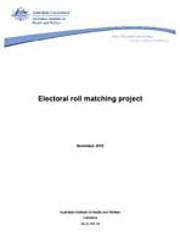Summary
High quality health information systems are essential for the provision of high quality population health services. The Computer Assisted Telephone Interview (CATI) health survey is an example of a practical and efficient method to collect health information. To conduct effective CATI surveys it is necessary to have access to representative population samples; typically, this means access to all potential active household telephone numbers. The aim of this electoral roll matching project is to test an alternative sampling frame—the electoral roll—as a starting point for accessing telephone numbers.
The analysis in this report was conducted by the Population Health Unit (PHU) at the Australian Institute of Health and Welfare (AIHW) using de-identified data provided by the AIHW Dental Statistics Research Unit (DSRU)—a collaborating unit of the AIHW located in the Australian Research Centre for Population Oral Health at the University of Adelaide.
The AIHW DSRU requested the Australian Electoral Commission (AEC) to extract a sample from the electoral roll. These data were matched against the Sensis MacroMatch database to append a residential telephone number. The most complete matches were used as the sampling frame for the 2008 National Dental Telephone Interview Survey (NDTIS) conducted by the AIHW DSRU. This report contains analysis of the match outcome and survey response outcome.
Key findings
- On average, just over half of the records (51.8%) were adequately matched between the electoral roll records and the Sensis MacroMatch database.
- Matching rates were not consistent across all states and territories; for example, the Northern Territory had the lowest match rate for males (33.7%) and Tasmania had the highest match rate for males (59.5%).
- There were no substantial differences in match proportions between males and females nationally or among states and territories.
- Higher proportions of females completed the survey than males.
- Survey completions were influenced by the do not call register (DNCR) status: people who registered were more likely to complete a survey than people who were not registered.
- People living in the non-metropolitan areas completed the survey at a greater rate than their metropolitan counterparts.
The results in this report suggest that it is feasible to access telephone listings for surveys by using the Australian electoral roll databases as a starting point. This report enables states and territories to determine their status on match and response outcomes, which may be useful for planning future survey programs.



